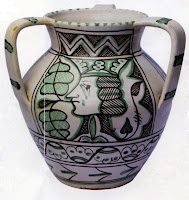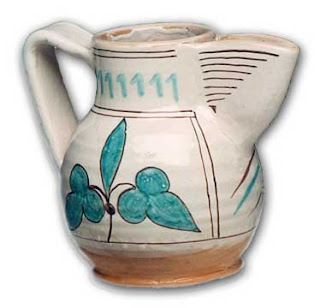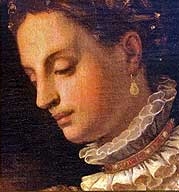In Deruta the recent fight against "fakes" of Deruta handmade ceramics has caused enormous troubles in the town of Deruta and within its community. The town Hall and the Consortium of Ceramicists called "Deruta 1282" were convinced that the problem of the market of handmade ceramics being stuck was due to counterfeits=Deruta patterns reproduced by the use of decals, plastic printed films over the glazing, considered as fakes. A variation of the low quality products painted in China and in Romania. Therefore in 2008 they started a campaign against counterfeits. Before going to China or to Romania, they started by attacking local producers: a couple of decal ceramics factories are located in the city of Deruta and another one was located in the neighborhood of Assisi.
 |
| The presentation photo of decal Deruta dinnerware sets in the "Sur la Table" online store, called Deruta-style. Photo credit: Sur La Table |
One of the companies in Deruta that produces decal tableware is the official supplier of the U.S. company "Sur la Table", chain stores first established in Seattle, Pike Place Market in 1972. Sur la Table on their online store advertise their decal product from Deruta as "Deruta-style collection". Worth of notice is that small parts of the products are handpainted, such as the rims on the plates or the top of the salt and pepper shakers.
These decal ceramics can be designated as "decorated by hand", where the word "decorated" as a literal translation of "decorato" means that a person lays down a piece of printed film on the surface of the plate with the use of their hands. The verb "decorare" in Italian also means "painting by hand"; "decoratrice" (for a woman) "decoratore" (for a man) is the name for the ceramics artists on their official paperworks.
Decal has been in use in Deruta for many years, companies such as "Ars Artigiana" have experimented this technique several years ago as well as "Santucci ceramics" which supplied the Perugina chocolate company with ceramics items to go with their candy products.
Probably the point was that it is not legitimate to reproduce traditional handpainted patterns by the use of decals and by using the name of the town of Deruta. The question is: how can you fulfill the demand of chain stores and their customers who wish to have the flavor of handpainted traditional ceramics on their table at a reasonable price?
- Original Posts by Roberta Niccacci -
-----------------------------------------
FRIENDS OF CAMA































